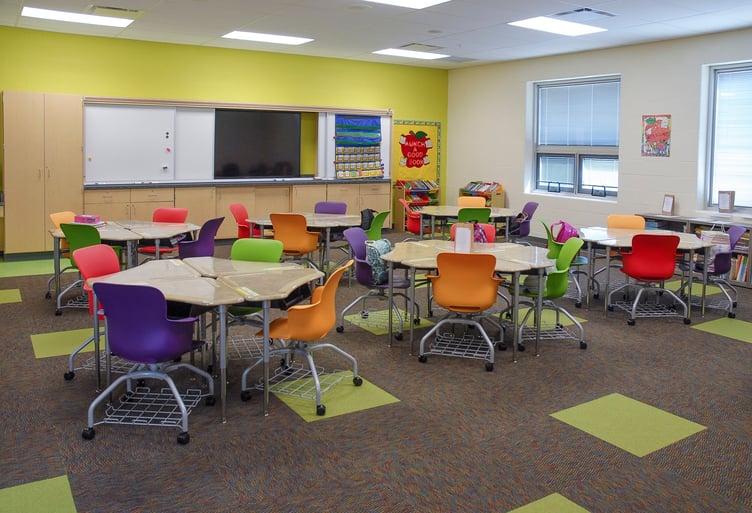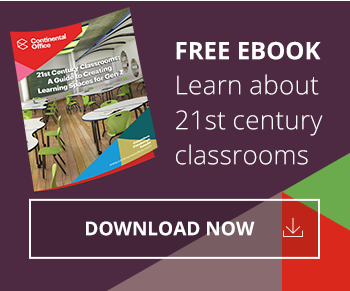As I travel around the country talking with educators about learning space redesign, I hear of some schools successfully transitioning into 21st century learning spaces while others are struggling. In the successful schools the educators are seeing positive results in the new spaces; in the other schools the educators are becoming frustrated. In some cases they are even facing opposition. So I began to ask myself, “What are the common points I’m seeing in the schools that are successful? What do educators need to know to accomplish this shift?” Here are some answers.
First and foremost, the successful schools understand that Gen Z (those students born since 2000) are very different from previous generations. They are growing up connected. It’s estimated today that 92% of all American infants are on the internet, many of them before they are born when their sonogram pictures are posted by proud parents. Many preschoolers have their own iPads, which often come with interactive learning games. Mattel, the maker of the iconic Barbie dolls, now makes an interactive device called Aristotle that recognizes kids’ voice patterns, sings lullabies to them, and can help them with their homework. Walk into any middle school or high school cafeteria and you’ll see kids watching videos on their phones or playing games online with their friends and then sharing their high scores on Snapchat. It’s a new type of world for these students, and they need new types of learning spaces.
Today’s students need colors, movement, and choice — which are elements educators need to incorporate into furniture for classrooms, hallways, cafeterias, and any place students are learning.
Successful schools:
- add bright, comfortable furniture
- allow the students to move around (and move the furniture) so they can work independently, in pairs, and in groups
- give students choice in the types of furniture they use; sometimes students want to sit in a regular desk and other times they want to sit at a high top table or on an exercise ball

A New Mindset, A New Space
It’s not enough to just create a new type of space and hope improved learning will naturally follow. The space is only as good as the teaching and curriculum found within it. As educators adjust their learning space, they should adjust another space — their thinking space. The days of the educators being the masters of dissemination are over. Today it’s about facilitation. Instead of controlling every part of the curriculum, teachers must guide students through it. Students must be encouraged to think critically, collaborate, communicate, and be creative. The object of today’s curriculum is not to learn a set of fixed outcomes, but to be able to rapidly adapt to an unpredictable future — and this means students must have learning spaces that allow them to think quietly, work in pairs and small groups, make presentations, and plug into their technology. They’re not memorizing anymore; they’re thinking. They need fun, comfortable spaces. Teachers must be brave enough to try new ideas, trust their students to tell them how they learn best, and turn them loose in these new learning spaces.
To make the most of a new space, teachers must incorporate global skills throughout their standards-based curriculum, rapidly implement ways for students to use technology, and give students more choices in how they learn.
Successful schools:
- ensure their teachers are aware of the global skills needed to be successful in the 21st century
- allow students to use laptops, tablets, and personal devices in new spaces to be creative, do research, use educational apps, and share content
- give students choices in their content, assessment, and the time it takes to complete assignments
Students and Teachers: The New Partners
The most important point for moving into a new learning space is for school leaders to involve the students and teachers in the design of the space. When students and teachers are involved from the outset, they understand the reasoning for the new space and begin to imagine how they can creatively use it. If they are not involved, they’ll walk into a new type of space they don’t understand and won’t appreciate; the transition will be much more difficult. In the 20th century leadership models, the administrators made the decisions and the teachers and students fell into line. That paradigm has been replaced by one in which leadership is distributed throughout the organization. In today’s world, people want to be involved. This is particularly true of Gen Z students; they are growing up with choices and decisions. Plus, this task is just too complicated for administrators to tackle alone — the students and teachers are their new partners and must be allowed to share ideas and ownership.
To ensure new learning spaces are used productively from the first day, administrators must communicate and involve stakeholders.
Successful schools:
- invite students and teachers to play key parts in designing new spaces
- take their students and teachers to architecture and design offices to experiment with different furniture styles, paint colors, and carpet designs, to understand what these companies are creating, and to offer their input
- constantly communicate with students and teachers (and parents and community members) about progress to keep them informed and to build excitement for the new space
From Here to the New Frontier
I’ve often told educators that learning space is the new frontier of education — and it’s only natural that anyone transitioning into a new frontier will need help. To make the most of the opportunity, and dollars, educators need to find a design company with a representative who cares about them and their project.
That representative will:
- guide them to high quality, durable school furniture; schools should avoid the cheap furniture found in discount stores — it won’t last long
- form a common vision with students and teachers and help them understand how to select and use new types of products
- help the overall vision for space redesign fall into place
Learning space will continue to morph as new types of students enter schools. While it’s hard to predict all of the changes coming in a disrupted future, we know learning space needs will continue to shift with learning styles and new global skills. The era of a set curriculum and straight rows of student desks has ended, which means learning space design is more than a fad or a luxury — it’s a necessity for all 21st century schools.





Comments